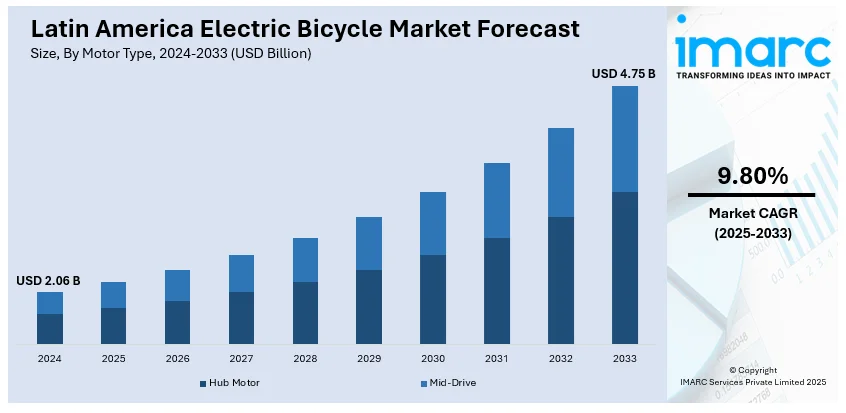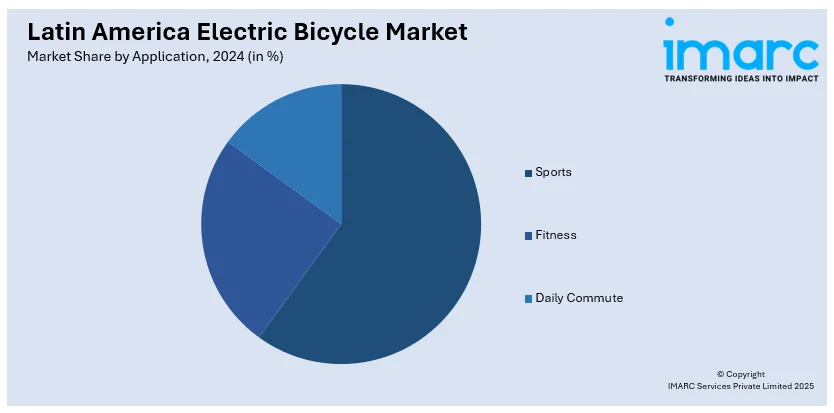
Latin America Electric Bicycle Market Size, Share, Trends and Forecast by Motor Type, Battery Type, Application, Consumer Segment, Power Output, and Country, 2025-2033
Latin America Electric Bicycle Market Overview:
The Latin America electric bicycle market size reached USD 2.06 Billion in 2024. Looking forward, IMARC Group expects the market to reach USD 4.75 Billion by 2033, exhibiting a growth rate (CAGR) of 9.80% during 2025-2033. The market is expanding rapidly as a result of increased environmental awareness, rapid urbanization in the region, the implementation of various government initiatives, major expansion in the tourism industry, and emerging health and wellness trends.
|
Report Attribute
|
Key Statistics
|
|---|---|
|
Base Year
|
2024 |
|
Forecast Years
|
2025-2033
|
|
Historical Years
|
2019-2024
|
| Market Size in 2024 | USD 2.06 Billion |
| Market Forecast in 2033 | USD 4.75 Billion |
| Market Growth Rate (2025-2033) | 9.80% |
Latin America Electric Bicycle Market Trends:
Environmental Awareness
Latin America is increasingly facing environmental challenges, with urban air pollution and rising greenhouse gas (GHG) emissions being key concerns. In comparison to vehicles and motorcycles, e-bikes offer a sustainable mode of transportation with zero exhaust emissions, greatly lowering urban air pollution. As cities become more aware of their carbon footprints, there is a growing shift toward electric mobility. Governments, in collaboration with environmental agencies, are launching awareness campaigns and supporting eco-friendly transport modes to encourage sustainable living. Such programs help in reducing greenhouse gases and enhancing public health by minimizing pollution-related illnesses. As a result, residents are becoming more inclined toward sustainable options like e-bikes, further supported by financial incentives and public programs promoting environmental responsibility. For instance, in December 2023, the U.S. International Development Finance Corporation (DFC) and IDB Invest invested USD 23 Million in Tembici to expand electric bike-sharing services in Latin America. This initiative will increase Tembici’s users from 300,000 in 2023 to over 1 million by 2029, tripling trips to 600 million and reducing CO2 emissions equal to removing 15,000 cars. The project supports local employment in Brazil, promotes urban mobility, and advances carbon credit transparency through a Digital Measuring Reporting and Verification (DMRV) system.

Government Initiatives and Incentives
Government initiatives are pivotal in driving e-bike adoption across Latin America. Governments in several countries are implementing favorable policies to promote electric mobility. These policies include tax breaks, subsidies on e-bike purchases, and investment in cycling infrastructure, such as bike lanes and charging stations. Such support makes e-bikes an economically viable alternative to traditional vehicles, especially for low-income families and young professionals. Additionally, governments are partnering with private companies to launch e-bike sharing programs in urban centers, providing residents with cost-effective and accessible options for commuting. For instance, Mexico City’s Ecobici program, the largest bike-sharing system in Latin America, operates over 6,000 bikes alongside a competitive ride-hailing market with 200,000+ drivers. Shared mobility services in Bogotá, Mexico City, and Curitiba are transforming urban transport, with Curitiba’s BRT system serving 45% of residents. Government initiatives often extend to public awareness campaigns that highlight the environmental and economic benefits of e-bikes, encouraging people to switch to this mode of transportation.
Latin America Electric Bicycle Market Segmentation:
IMARC Group provides an analysis of the key trends in each segment of the market, along with forecasts at the region/country level for 2025-2033. Our report has categorized the market based on motor type, battery type, application, consumer segment, and power output.
Motor Type Insights:
- Hub Motor
- Mid-Drive
A detailed breakup and analysis of the market based on the motor type have provided have also been provided in the report. This includes hub motor and mid-drive.
Battery Type Insights:
- Lead Acid
- Lithium ion (Li-ion)
- Others
A detailed breakup and analysis of the market based on the battery type have provided have also been provided in the report. This includes lead acid, lithium ion (Li-ion), and others.
Application Insights:

- Sports
- Fitness
- Daily Commute
A detailed breakup and analysis of the market based on the application have provided have also been provided in the report. This includes sports, fitness, and daily commute.
Consumer Segment Insights:
- Urban
- Rural
A detailed breakup and analysis of the market based on the consumer segment have provided have also been provided in the report. This includes urban and rural.
Power Output Insights:
- Less Than 250W
- From 250W to 400W
- From 401w to 700W
- Above 751W
A detailed breakup and analysis of the market based on the power output have provided have also been provided in the report. This includes less than 250W, from 250W to 400W, from 401W to 700W, and above 751W.
Country Insights:
- Brazil
- Mexico
- Argentina
- Colombia
- Chile
- Peru
- Others
The report has also provided a comprehensive analysis of all the major regional markets, which include Brazil, Mexico, Argentina, Colombia, Chile, Peru, and others.
Competitive Landscape:
The market research report has also provided a comprehensive analysis of the competitive landscape. Competitive analysis such as market structure, key player positioning, top winning strategies, competitive dashboard, and company evaluation quadrant has been covered in the report. Also, detailed profiles of all major companies have been provided.
Latin America Electric Bicycle Market News:
- In June 2024, LOBO EV Technologies Ltd., an innovative e-bicycle producer and seller, has increased its market share in Latin America by working with well-known electric mobility retailers in Brazil.
- In June 2024, LOBO EV Technologies received its largest 2024 order from Ecuadorian wholesalers, including nine containers of e-bikes, e-trikes, and solar-powered "King of the Load" e-trikes. This strengthens its Latin American market presence, with prior orders from Brazil, Chile, and Suriname
Latin America Electric Bicycle Market Report Coverage:
| Report Features | Details |
|---|---|
| Base Year of the Analysis | 2024 |
| Historical Period | 2019-2024 |
| Forecast Period | 2025-2033 |
| Units | Billion USD |
| Scope of the Report |
Exploration of Historical Trends and Market Outlook, Industry Catalysts and Challenges, Segment-Wise Historical and Future Market Assessment:
|
| Motor Types Covered | Hub Motor, Mid-Drive. |
| Battery Types Covered | Lead Acid, Lithium Ion (Li-Ion), Others |
| Applications Covered | Sports, Fitness, Daily Commute |
| Consumer Segments Covered | Urban, Rural |
| Power Outputs Covered | Less Than 250W, From 250W To 400W, From 401W To 700W, Above 751W |
| Countries Covered | Brazil, Mexico, Argentina, Colombia, Chile, Peru, Others |
| Customization Scope | 10% Free Customization |
| Post-Sale Analyst Support | 10-12 Weeks |
| Delivery Format | PDF and Excel through Email (We can also provide the editable version of the report in PPT/Word format on special request) |
Key Questions Answered in This Report:
- How has the Latin America electric bicycle market performed so far and how will it perform in the coming years?
- What is the breakup of the Latin America electric bicycle market on the basis of motor type?
- What is the breakup of the Latin America electric bicycle market on the basis of battery type?
- What is the breakup of the Latin America electric bicycle market on the basis of application?
- What is the breakup of the Latin America electric bicycle market on the basis of consumer segment?
- What is the breakup of the Latin America electric bicycle market on the basis of power output?
- What are the various stages in the value chain of the Latin America electric bicycle market?
- What are the key driving factors and challenges in the Latin America electric bicycle market?
- What is the structure of the Latin America electric bicycle market and who are the key players?
- What is the degree of competition in the Latin America electric bicycle market?
Key Benefits for Stakeholders:
- IMARC’s industry report offers a comprehensive quantitative analysis of various market segments, historical and current market trends, market forecasts, and dynamics of the Latin America electric bicycle market from 2019-2033.
- The research report provides the latest information on the market drivers, challenges, and opportunities in the Latin America electric bicycle market.
- Porter's five forces analysis assist stakeholders in assessing the impact of new entrants, competitive rivalry, supplier power, buyer power, and the threat of substitution. It helps stakeholders to analyze the level of competition within the Latin America electric bicycle industry and its attractiveness.
- Competitive landscape allows stakeholders to understand their competitive environment and provides an insight into the current positions of key players in the market.
Need more help?
- Speak to our experienced analysts for insights on the current market scenarios.
- Include additional segments and countries to customize the report as per your requirement.
- Gain an unparalleled competitive advantage in your domain by understanding how to utilize the report and positively impacting your operations and revenue.
- For further assistance, please connect with our analysts.
 Inquire Before Buying
Inquire Before Buying
 Speak to an Analyst
Speak to an Analyst
 Request Brochure
Request Brochure
 Request Customization
Request Customization




.webp)




.webp)












